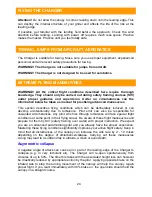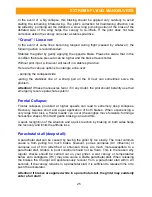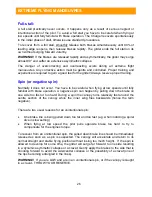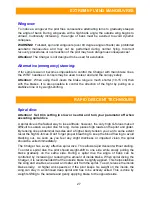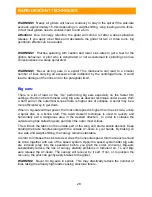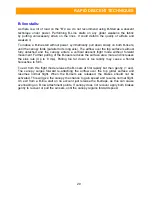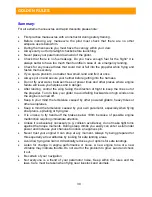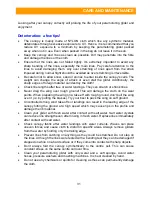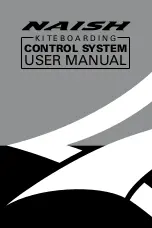
16
FLYING THE CHARGER
Getting ready for Flight
Put on the harness/paramotor with care and check that the handle of the reserve
parachute is securely fastened to prevent accidental deployment. Look to see that the
flaps of the outer container are fastened securely and correctly. The main carabineers
must also be checked carefully. Replace carabineers if any damage is visible or if you
have accumulated 300 flying hours. Finally, connect the paraglider risers to your
harness with the main self-locking carabineers. Check carefully that they are properly
closed.
ATTENTION! Never fly with an open main carabineer!
ATTENTION! Do not take off if you find any damage on your equipment!
Forward Launch Technique
The Charger is very easy to launch. With a very weak or zero wind it requires an
appropriate launch technique. Before take-off, recheck the canopy, trimmer setting, wind
direction and the air space around you. When you are ready to take off, hold all A-risers
and the brake handles in each hand. If there is wind present then just hold the centre A
risers in each hand.
The A-lines are identified by red coloured sleeves on the risers. Before take-off, place
yourself in the centre of the glider while holding the A risers. Let the B, C and D risers
fall into the bend of your arm. Continue holding the A risers with arms outstretched
behind you. Pull up the canopy with good forward momentum. (The stronger the
headwind the fewer run-ups you need plus less pull on the A’s to inflate your canopy).
After the initial inflation you may need to keep applying forward pressure on the A-risers
depending on the wind conditions. Do not pull down on the A’s.
1. Paragliding forward technique
– Follow the above technique to get the glider
overhead. As soon as the glider is above you, stop pulling on the A-risers. A good
progressive run ensures your Charger will inflate and come up equally and quickly. If the
canopy should surge forward, control it by gently braking. Next, do quick visual checks
of the canopy looking upwards to ensure the canopy is completely open (otherwise,
abort the take-off). Only then is the final decision to continue the launch. If anything
doesn’t feel completely safe, the launch should be aborted. If the glider feels solid and
evenly inflated continue moving forward until the glider lifts you off. It is easier to take-off
in a light headwind by applying the brakes slightly. After the take-off, gently release the
brakes to gain forward momentum. Shortly after take off the brakes should be gently
reapplied to stabilize the glider during cruising flight and possibly correcting for drift.
2.
Paramotoring technique –
Layout and start the inflation technique the same as
stated above.
Once the canopy is
inflated up to the angle of about 80° degrees, open up
the throttle to full power and lean back. This helps counter the engines thrust allowing it
to push you forward rather than leaning forward towards the ground. Continue to run in
an upright position. This is important. When you approach take off speed gently apply
the brakes (max 30% of the brake range). The faster the trimmer setting is, the more
brake input is required for take-off. Set the trimmers to neutral for easy launching. Once
you
Summary of Contents for CHARGER
Page 1: ...1 ...
Page 10: ...10 TRIMMING ...
Page 35: ...35 LINE PLAN SCHEME ...
Page 38: ...38 ...
Page 40: ...40 ...























